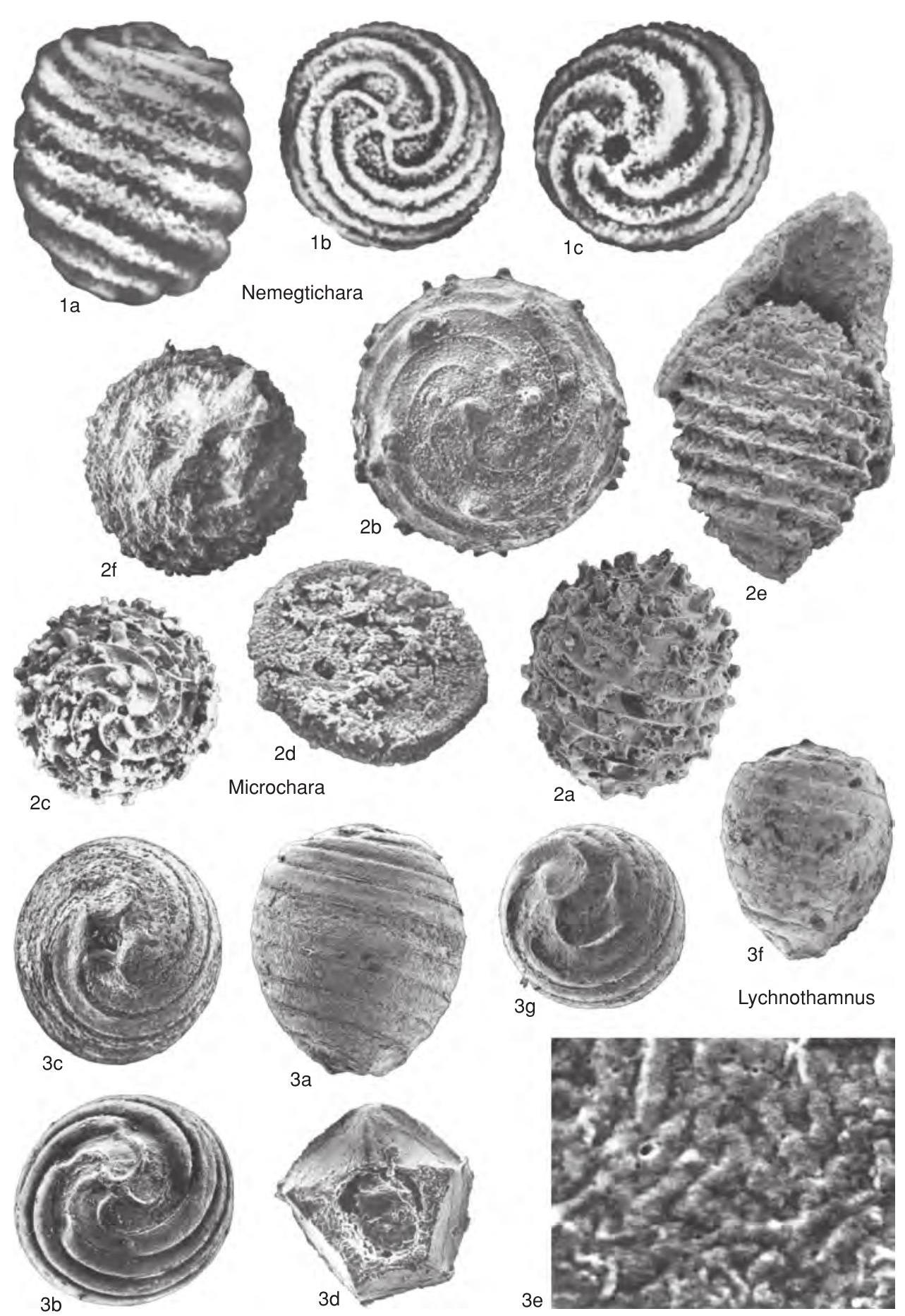Welcome to the Treatise on Invertebrate Paleontology!
Please enter a genera name to retrieve more information.

Microchara
Classification
Phylum:
Charophyta
Class:
Charophyceae
Order:
Charales
Suborder:
Charineae
Family:
Characeae
Subfamily:
Charoideae
Formal Genus Name and Reference:
Microchara Grambast, 1959b, p. 6, Gobichara Karczewska & ZIEMBIŃSKA-TWORZYDŁO, 1972, p. 72
Type Species:
M. hystrix GRAMBAST, 1959b, p. 7, fig. 1, OD
Images
(Click to enlarge in a new window)
Fig. 69,2a-d. * M. hystrix Grambast, lower Eocene, France, a, holotype, lateral view, C.63-4, x80, b, apical view, C.2-4, x110, c, basal view, C.63-7, x80, d, basal plate, C.63-8, x660 (new).——Fig. 69,2e-f. M. vestita Castel, lower Eocene, France, e, lateral view of specimen, tunicate in upper part around site of missing coronula cells, x124, f, apical view, with remains of 3 coronula cells, x105 (Feist-Castel, 1975, pl. II, 11,10 )
Synonyms
Gobichara
Geographic Distribution
Argentina, France, Spain, China, Mongolia, India
Age Range
Beginning Stage in Treatise Usage:
Upper Cretaceous-Paleogene (middle Eocene)
Beginning International Stage:
Lutetian
Fraction Up In Beginning Stage:
0
Beginning Date:
48.07
Ending Stage in Treatise Usage:
Paleogene (middle Eocene)
Ending International Stage:
Bartonian
Fraction Up In Ending Stage:
100
Ending Date:
37.71
Description
Apex psilocharoid, with little or no modification, General shape subprolate, with apex rounded and base narrowed, in some species base projecting, Gyrogonites often with tubercles or crests, ornamentation reaching apex center, Basal plate very thin, not visible from exterior, Size generally small, in some species small to medium. [ Gyrogonites of Microchara with tapered bases are difficult to distinguish from small specimens of Harrisichara. These resemblances may indicate a phylogenetic relationship between the two genera..]
References
Museum or Author Information
Classification
Phylum:
Charophyta
Class:
Charophyceae
Order:
Charales
Suborder:
Charineae
Family:
Characeae
Subfamily:
Charoideae
Formal Genus Name and Reference:
Microchara Grambast, 1959b, p. 6, Gobichara Karczewska & ZIEMBIŃSKA-TWORZYDŁO, 1972, p. 72
Type Species:
M. hystrix GRAMBAST, 1959b, p. 7, fig. 1, OD
Images
(Click to enlarge in a new window)
Fig. 69,2a-d. * M. hystrix Grambast, lower Eocene, France, a, holotype, lateral view, C.63-4, x80, b, apical view, C.2-4, x110, c, basal view, C.63-7, x80, d, basal plate, C.63-8, x660 (new).——Fig. 69,2e-f. M. vestita Castel, lower Eocene, France, e, lateral view of specimen, tunicate in upper part around site of missing coronula cells, x124, f, apical view, with remains of 3 coronula cells, x105 (Feist-Castel, 1975, pl. II, 11,10 )
Synonyms
Gobichara
Geographic Distribution
Argentina, France, Spain, China, Mongolia, India
Age Range
Beginning Stage in Treatise Usage:
Upper Cretaceous-Paleogene (middle Eocene)
Beginning International Stage:
Lutetian
Fraction Up In Beginning Stage:
0
Beginning Date:
48.07
Ending Stage in Treatise Usage:
Paleogene (middle Eocene)
Ending International Stage:
Bartonian
Fraction Up In Ending Stage:
100
Ending Date:
37.71
Description
Apex psilocharoid, with little or no modification, General shape subprolate, with apex rounded and base narrowed, in some species base projecting, Gyrogonites often with tubercles or crests, ornamentation reaching apex center, Basal plate very thin, not visible from exterior, Size generally small, in some species small to medium. [ Gyrogonites of Microchara with tapered bases are difficult to distinguish from small specimens of Harrisichara. These resemblances may indicate a phylogenetic relationship between the two genera..]
